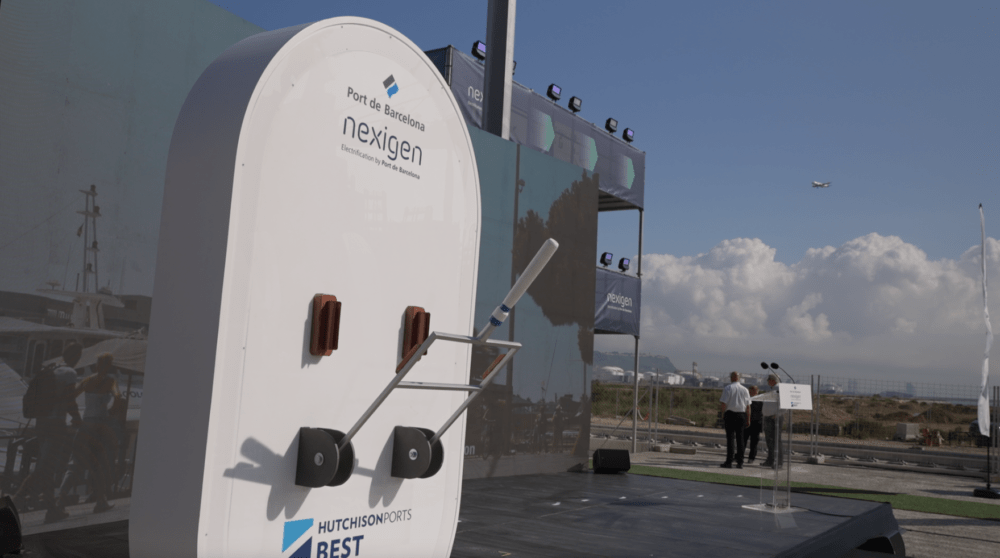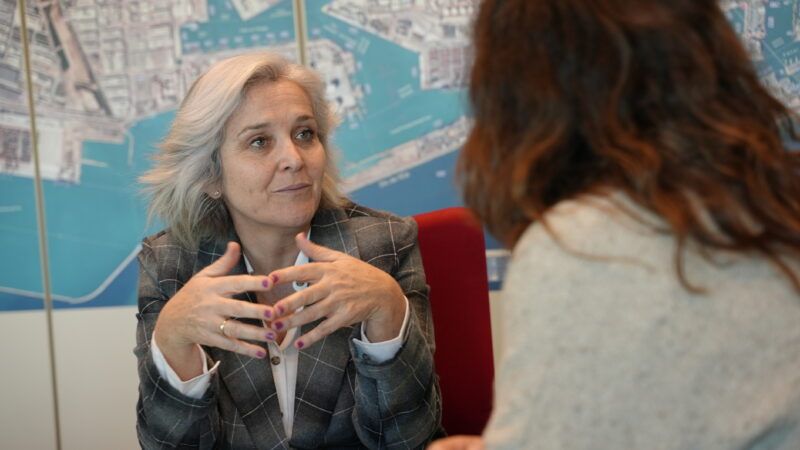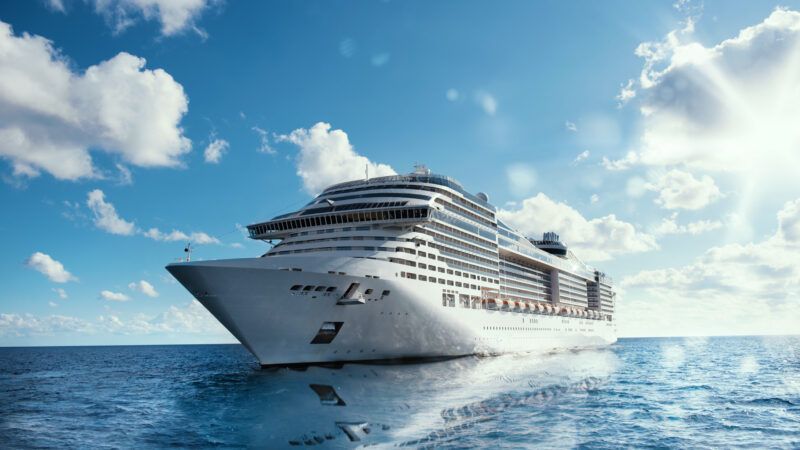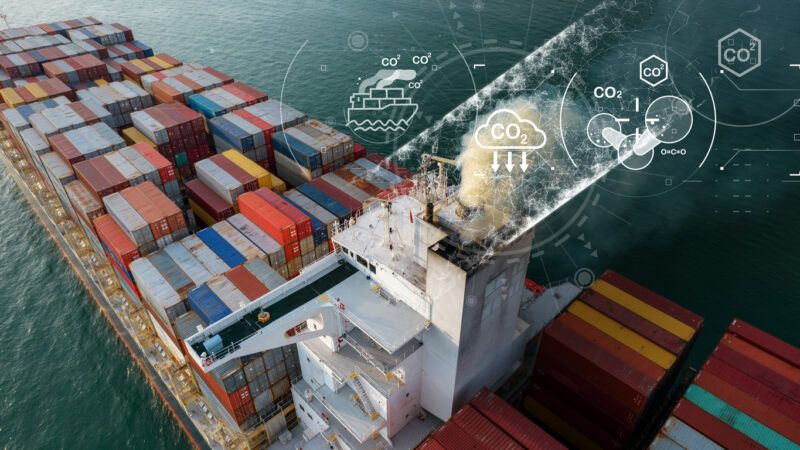
Onshore Power Supply is already a reality at the Port of Barcelona
The Port of Barcelona has inaugurated the Onshore Power Supply (OPS) system at the Hutchison BEST Terminal. This operation has involved the deployment of a medium voltage network with 3,000 meters of cable to the dock so that the container ships can turn off their auxiliary engines and connect to an electrical network of 100% renewable origin. Six years before it becomes mandatory in European ports, Barcelona has already done its homework.

Hamburg in January and now Barcelona. Both ports are pioneers in Europe having successfully completed the installation of the Onshore Power Supply (OPS), which will establish an electrical connection between the quay and the berthed container ships so that they can turn off their auxiliary engine and save tons of CO2 emissions.
This system will be mandatory by 2030 in Europe as a key measure to decarbonize ports and the maritime sector.
In the case of the Port of Barcelona, this is the first system for supplying electricity from renewable sources to ships in a container terminal of a Mediterranean port. This service has begun to be offered at the Hutchison Ports BEST terminal and is part of the NEXIGEN plan, which has five phases to be completed by 2050.
“The OPS has been specifically designed to be compatible with the BEST terminal operation and will allow up to two ships to be connected simultaneously, adapting the electrical current to the needs of each ship,” he tells PierNext Bruno Hervàs, official shorepower data engineer of the Port of Barcelona.
The pier has three junction boxes specifically designed to be integrated into the terminal, and according to the estimated calculations, a container ship stays 41.18 hours at berth, during which time it consumes 73.02 MWh of energy and, thanks to the OPS, 49.16 tons of CO2 will be saved. Annually, 2,500 tons of CO2 will be eliminated, the equivalent of about 135,000 cars driving at 30 km/h for a year.
OPS challenges for ports
Pioneering the implementation of the OPS system in Europe has involved a number of technical challenges and has been “quite a challenge,” describes Carlos Guerra, electrification engineer at the Port of Barcelona.
“Basically, this is a very new technology in Europe and we have practically started from scratch. We are pointing the way forward for the rest of the Spanish ports,” he says.
Guerra shares that they have been in close contact with the port of Hamburg, making visits to their facilities and exchanging information, as well as with European entities for the drafting of regulations.
Álvaro Rodríguez, president of Puertos del Estado, said during the inauguration event that they are working to reconcile two regulations; the port and the electricity sector, to “allow power terms to be reduced as much as possible and the price charged for the supply of electricity to be competitive. We are also working with Red Eléctrica to transmit in its new development plan what the electrical grid of the future has to be and the needs of the ports for projects like this,” he explained during the presentation of the Port of Barcelona's OPS system.
Rodriguez ended his presentation by sharing a couple of facts: the supply of electricity to ships will mean that all ports will have to double their electricity consumption by 2030 and, “what is much more important, a fivefold increase in installed power,” he said.
OPS challenges for ships
As for container ships and other vessels that will be connected to the power grid, Hervàs, official shorepower data engineer at the Port of Barcelona, explains that the vessels will be equipped with electrical switchgear similar to that found on land; essentially transformers and frequency converters.
At the stern of the ship is a small container with a cable reel that runs down to the dock and plugs into the junction box. This cable goes to electrical panels, also specific to the OPS, where the electricity conversion takes place.
“A specificity specific to ships is that their electronics are very sensitive to frequency and voltage variations and can break down very easily. A lot of the equipment runs on electric motors with variable speed. To avoid damage to these motors, the electricity on board must be very well controlled, both in terms of voltage and frequency. The ships have electrical panels on board that manage and control the electricity so that it is as stable as possible and does not generate problems in the installation.
Bruno Hervàs, official shorepower data engineer of the Port of Barcelona
In this sense, Hervàs points out that they do not necessarily have to be new generation ships, although practically all ships, container ships, cruise ships and ferries, already have this facility. Those that do not, are undergoing a retrofit to be ready.
“Installing this system on container ships is relatively easy because they have a lot of space in the area where they are housed. On the other hand, on ferries and cruise ships it is more complicated because you have to find a place for them, since they are equipment that takes up a lot of space, plus an additional electrical panel that has to be added in the engine room.”
One of the problems, explains the engineer, is that there are few manufacturers supplying this equipment to ships. Although technologically speaking they are not excessively complicated equipment, they are large and the powers are very high, which is generating long waiting times and an important bottleneck.
“Connecting ships is very complex, as not everyone is ready,” shares Ana Arévalo, head of the Shorepower department at the Port of Barcelona. For this reason, the person in charge of coordinating the project in Barcelona recommends taking it one step at a time.
“Safety must be a priority, so we are going to develop many tests to be able to make a first assessment of the system in December and analyze the data obtained, such as the number of emissions we have avoided or how many ships have been connected.”
Ana Arévalo, head of the Shorepower department of the Port of Barcelona
Pilots at BEST and Grimaldi terminals
In the next two years, the Port of Barcelona will carry out two pilots to test the connections with two types of ships; container ships and ferries.
The operation is as follows: when the ship arrives at the dock, it shuts down the auxiliary engines and connects to the shore grid to generate electricity. “The OPS takes the current from the shore grid at 25,000 volts, transforms it to 6,600 volts, which is the power at which the ship operates and, if the ship needs it, transforms the 50 Hertz that we have here in Spain to the 60 Hertz that the ship has,” Hervàs explains.
In the case of the ferries, the Port has an agreement with Grimaldi for the pilot project, which will consist of connecting, on a daily basis, the Ciudad de Sóller, which makes the Palma-Barcelona route every day.
During the month of July and in August, real connection tests will begin at the BEST terminal, said Hervás.
“Starting in September, the forecast is to make one connection a week to reach 40 connections the first year, which is what we have by tender, and 52 the second year. From 2026 we will increase to 125 a year. In 2028 or 2029 the figure will double to 350 connections per year.”
The objective of the tests will essentially be to check that everything is working properly and that there are no overloads on the equipment. “One of the complex aspects is the monitoring, management and control system, although everything is electronic and automated. We have calculated average connections of 40 hours, so it is not unfeasible to constantly monitor that everything is working as planned, although the system can be accessed remotely, even from a cell phone,” he says.
The engineer shares that, in addition to the OPS, the ports are trying to electrify the devices and elements that are part of the operation as much as possible.
“Terminals are increasingly buying hybrid or electric machinery. The idea is that all the operation within the port will be supplied with renewable electric energy. We hope, in the not too distant future, to be able to do it with hydrogen, according to the port's sustainability and decarbonization plan.”
For the moment, the Port of Barcelona has already achieved a major milestone and a giant step towards the decarbonization of port activities and the maritime sector as a whole.
This project has received funding through the Sustainable and Digital Transport Support Program (PATSYD) of the Spanish Ministry of Transport and Sustainable Mobility. This program is part of the Recovery, Transformation and Resilience Plan (PRTR) with NextGenerationEU funds.







